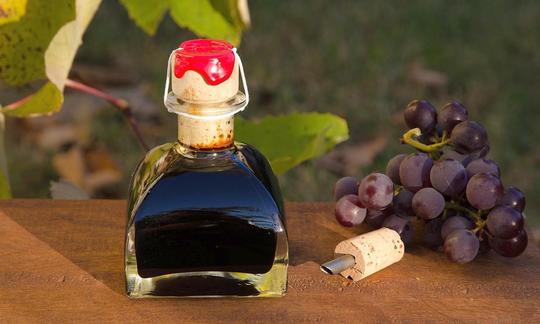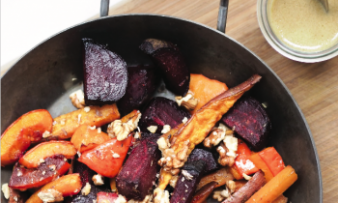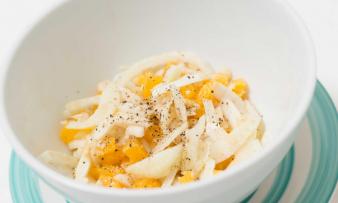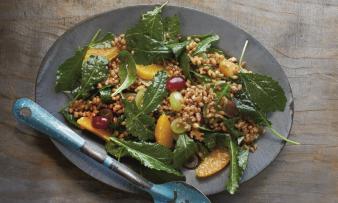Table of contents
Balsamic vinegar (Aceto balsamico) (organic) has many faces. From traditional craftsmanship to industrial products, ingredients can vary greatly.
Use in the kitchen
Balsamic vinegar is used as a seasoning. In some countries it is also considered a healthy drink. Traditional balsamic vinegar from Modena or Reggio Emilia is expensive and is only used sparingly to set accents or as a garnish. The cheaper variant, 'Balsamico di Modena', is good as a dressing or marinade. It gives a sweet and sour taste. Balsamic vinegar can also be reduced to a thick glaze. Balsamic vinegar is an ideal ingredient in dips, as a topping or in sauces. The combination of sweet and sour on fruit and berries creates a delicious taste experience.
Is balsamic vinegar vegan? During the production process, no animal products are usually used. Certified balsamic vinegar must not contain any additives. Many balsamic products on the market imitate traditional balsamic vinegar and can also contain animal ingredients (honey and whey). The ingredients can vary greatly from product to product. In industrially produced balsamic vinegar (not geographically protected), additives are permitted: thickeners, preservatives, colorings, flavors and other types of additives (both artificial and natural). 2 There is no general assessment of whether these additives are vegan. Take your time to check the ingredients. Also look for organic and origin certificates.
Homemade preparation
Original balsamic vinegar matures for many years in barrels made of chestnut wood, mulberry wood, juniper wood, cherry wood, ash wood and oak wood. The art of balsamic vinegar production is hard to replicate at home. Here is a cheap, healthy (and cheated) preparation:
You will need 6 cardamom pods, 12black peppercorns, 12 raisins, 1 teaspoon dried rosemary, 1 teaspoon dried sage, 4 cloves and 300 ml apple cider vinegar.
Mix all the ingredients together with a hand blender. The "balsamic vinegar" should be left in the sun for two months. Then strain the vinegar and bottle it.
Vegan recipe for balsamic mushroom pasta
Ingredients (3 servings): 250 g pasta (e.g. vegan wholemeal spaghetti), 2 tbsp rapeseed oil (optional), a red onion finely diced, 4 garlic cloves chopped, 350 g mushrooms, 3 tbsp balsamic vinegar (organic), 2 tbsp soy sauce, 1 tsp fresh or dried thyme leaves, 1 tsp paprika powder, 120 ml white wine (optional), salt andpepper to taste
To garnish: 3–4 tbsp pine nuts, 2–3 tbsp yeast flakes, fresh parsley
Method: Bring a large pot of salted water to a boil. Add the pasta and cook according to the instructions on the packet until al dente. Then drain the pasta through a sieve, reserving some of the pasta water (about 2/3 cup). Meanwhile, slice the mushrooms and fry them in a large pan for 2-3 minutes, until golden brown on one side. Then flip, reduce the heat a little and fry for a further two minutes. Now add the onions and cook for a further 2 minutes, add the garlic and fry for a further minute, stirring occasionally. Add a little water or oil as needed to prevent the vegetables from sticking too much. Stir in the balsamic vinegar, soy sauce, thyme leaves, paprika powder until the mushrooms are evenly coated with the marinade. Then deglaze with the white wine and simmer for 1-2 minutes, until the liquid has almost completely evaporated. Finally, add the cooked pasta and the reserved pasta water to the pan and mix. Season with salt and pepper if necessary. Toast the pine nuts in a small pan without additional oil until golden brown. Finally, garnish the mushroom pasta with the toasted pine nuts and fresh herbs.
Vegan recipes with balsamic vinegar can be found under the note: " Recipes that have the most of this ingredient ".
| Not only vegans or vegetarians should read this: Vegans often eat unhealthily. Avoidable nutritional mistakes. |
Purchasing - Storage
Due to the long shelf life of balsamic vinegar, it is in season all year round. Major retailers such as Coop, Migros, Denner, Volg, Spar, Aldi, Lidl, Rewe, Edeka, Hofer, Billa or organic supermarkets (e.g. Denn's Biomarkt and Alnatura) have balsamic vinegar in their range.
The availability of balsamic vinegar varies depending on the size of the store, catchment area, etc. If you are interested, click on our recorded food prices for the DA-CH countries (above under the ingredient image). There you will find current prices from various supermarkets and their price development.
Storage tips
It is sufficient to store the vinegar in a closed container in a cool and dark place. To preserve the characteristic aroma of the balsamic vinegar, you should always close the container tightly after use.
Is your balsamic vinegar past its recommended shelf life? No problem. Due to its special properties, manufacturers are not legally required to specify an expiration date for vinegar. However, vinegar can have limited stability. This is especially true if you open a bottle of balsamic vinegar and then do not close it properly. 15 Taste and quality can deteriorate over time.
However, there are differences in quality. High-quality balsamic vinegars generally have no best-before date. 15 Inferior balsamic vinegar can have very different properties and may even spoil. Check the balsamic vinegar with your senses. If it smells unpleasant or has already formed mold, throw the vinegar away.
The long shelf life is a result of acetic fermentation, which involves the introduction of oxygen during the wine fermentation process. This causes aerobic bacteria, which require oxygen for their metabolism, to multiply. They oxidize the alcohol previously produced by the anaerobic bacteria and convert it into acetic acid.7 Acetic acid is the main component in vinegar and is recognized as an effective antimicrobial compound that prevents the growth of pathogenic and spoilage organisms in fermented foods. It also causes spoilage in beverages such as wine.16 Therefore, if you open a bottle of wine and leave it open for a long time, it turns into vinegar.14 So vinegar, for the most part, remains vinegar.
The only known biological problem is the development of AAB (Acetic Acid Bacteria) which produce exopolysaccharides known as the mother of vinegar. The 'mother', a gelatinous deposit, is not dangerous. This type of "spoilage" mainly happens when you open a bottle and store it for a long time without using the vinegar. 15
The shelf life of vinegar can also be limited by chemical changes to the detriment of the phenolic components. The visual appearance of vinegar changes in terms of color and turbidity. When oxygen enters the bottle, this catalyzes polymerization, which creates sediment. 15
Ingredients - Nutritional values - Calories
100 g of balsamic vinegar has 88 kcal. The macronutrients in 100 g of balsamic vinegar consist of 0 g fat, 17 g carbohydrates (15 g of which are sugar) and 0.49 g protein. 1
The three most important essential micronutrients in balsamic vinegar are manganese (0.13 mg/100g), potassium (112 mg/100g) and iron (0.72 mg/100g). These are relatively low values, especially when you consider that vinegar is only consumed spoonful by spoonful (1 tablespoon weighs about 15 g). 1
In terms of ingredients, balsamic vinegar is particularly interesting because of its antioxidants and phenolic acids. We will go into more detail about this in the following section.
You can find all the ingredients of horseradish, how much it covers your daily needs and comparison values with other ingredients in our nutrient tables below the ingredient image.
Health Effects
Is balsamic vinegar healthy? Vinegar in general has a variety of functional properties, including antibacterial, anti-infective, antioxidant, anticarcinogenic, blood sugar control, lipid metabolism regulation and weight reduction. The antibacterial and anti-infective effect of vinegar is mainly due to the presence of organic acids, although polyphenols and melanoidins may also contribute. Antioxidant properties of vinegars come mainly from polyphenols and melanoidins, each of which is influenced by the raw materials and fermentation conditions. The effects of some vinegars on blood sugar control, lipid metabolism regulation and weight loss are due to the acetic acid they contain, which is mainly produced by acetic acid bacteria during fermentation. In addition, coffee sophora (inhibits disaccharidase), ligustrazine (improves blood circulation) and other functional ingredients in vinegars also help support health. Regarding their anticarcinogenic properties, some vinegars have been shown to inhibit the growth of cancer cells in vitro and in vivo. However, these results are mainly derived from cell or animal experiments and the substances responsible are still unclear. 13
Traditional balsamic vinegar from Modena and Reggio Emilia is a potentially healthy natural product, made from boiled and concentrated local grape must in wooden barrels. 2 The maturation transforms the starting substances into a product with strong antioxidant capacity, rich in phenolic compounds such as phenolic acids, monomeric catechins, flavonols and tannins. Balsamic vinegar also contains other antioxidants such as melanoidins, which come from the Maillard and caramelization reactions that occur during the boiling of the must and the traditional balsamic vinegar maturation. Traditional balsamic vinegar can help provide antioxidant molecules that play an important role in the protective function of the gastrointestinal tract against peroxidation, thus limiting the formation of harmful lipid degradation products. The consumption of fruit, vegetables and all products derived from them is inversely associated with mortality from degenerative and coronary heart diseases. It is recognized that the protection against disease provided by fruits and vegetables is due to the presence of various antioxidants (in particular polyphenols). Researchers have shown that polyphenols have a protective effect on degenerative processes in the brain and have anti-inflammatory, anti-carcinogenic, anti-atherogenic and cardioprotective effects. 1 2 Consumption of balsamic vinegar may also reduce the risk of developing atherosclerosis. 11
In a study of 23 different fruit vinegars, researchers found the following phenolic compounds in balsamic vinegar: gallic acid, protocatechuic acid, caffeic acid, p-coumaric acid. Organic acids in the balsamic vinegars examined were tartaric acid and malic acid. Of the 23 different fruit vinegars, balsamic vinegar from Modena showed the highest antioxidant activity. 3 'Traditional balsamic vinegar from Modena' has a higher antioxidant effect than 'balsamic vinegar from Modena' - 'balsamic vinegar' has a lower polyphenol content than 'traditional balsamic vinegar'. 9
Oxidative stress is a major cause of chronic diseases such as liver, neurodegenerative and cardiovascular diseases. Antioxidants can help reduce this stress and neutralize free radicals. Fruit vinegars retain a significant amount of antioxidants from the fruit and have a higher antioxidant capacity compared to wine and fruit juices. In addition, the fermentation process can provide additional functional components such as organic acids that are absent or present in low amounts in raw fruit. Fruit vinegars have been associated with various health benefits, such as reducing oxidative stress in obesity, regulating lipid metabolism and protecting the liver. These beneficial effects are at least partly due to the antioxidant properties of fruit vinegars. 3
Fermentation is a key process in the production of fruit vinegars, where most of the organic acids are produced through chemical and microbial processes. Organic acids contribute to sensory quality and exhibit antimicrobial activities. They can also control blood sugar levels and regulate lipid metabolism. The most important organic acid in balsamic vinegar of Modena is tartaric acid. 3 One study showed positive effects of tartaric acid on intestinal function. Tartaric acid could potentially have a positive effect on reducing the risk of developing colon cancer. 6
Can you lose weight with balsamic vinegar? Balsamic vinegar adds flavor without adding many calories, making it a beneficial choice for people who want to reduce their calorie consumption. It is an ideal replacement for fatty, high-calorie dressings. In addition, animal studies have shown that the acetic acid it contains could suppress the accumulation of body fat. 10
All in all, how healthy is balsamic vinegar? Overall, balsamic vinegar is a good natural source of antioxidant polyphenols and organic acids in the diet. 3
Beware of counterfeiting: The protected Italian products are vulnerable to fraudulent imitations, not only in terms of adulteration of the acetic acid fraction (e.g. by adding synthetic acetic acid obtained from the fermentation of sugar cane or beet sugar), but also in terms of the sugar fraction, by adding a mixture of exogenous sugars. 4 The main sources of phenolic compounds in fruit vinegars are the raw fruits. Phenols play an important role in the sensory properties and health effects of fruit vinegars. 3
Balsamic imitations can be similar to 'Balsamic Vinegar of Modena' or 'Traditional Balsamic Vinegar' in terms of their commercial target audience. They can be liquid or very viscous, and are sometimes thickened with starch or other additives. Balsamic imitations can contain mixtures of vinegars from different sources, together with grape must, fruit juices, sugar and food additives to achieve the desired appearance and consistency. 2
Dangers - Intolerances - Side effects
Despite the health benefits, enjoy vinegar in small quantities. Too much acetic acid, which is contained in balsamic vinegar, can have a very negative effect on your health. 8
Ecological footprint
The ecological footprint of balsamic vinegar depends on many factors. A significant step in the production process and the resulting emissions is the cultivation of the grapes. The input factors of cultivation, such as energy (e.g. diesel for tractors), pesticide use, fertilizers, irrigation and land use changes are crucial. These factors differ greatly between organic and conventional wine production. Regardless of the cultivation method, the production and storage of balsamic vinegar can influence the ecological footprint. Packaging, distribution and the end of life of the packaging all contribute to the calculation. 17 We did not find exact figures for the ecological CO2 footprint of balsamic vinegar, but we did find figures for wine. Wine and balsamic vinegar can be compared because they are made from the same agricultural product.
In a study of the carbon footprint of the wine industry, diesel fuel consumption emerged as the main source of negative environmental impacts. A comparison of conventional and biodynamic viticulture revealed a big difference, as conventional agriculture uses synthetic pesticides and fertilizers, which have a negative impact on the environment and increase the ecological footprint. In addition, different studies on the CO 2 balance of wine were compared and values between 0.22 kg CO 2 eq/kg and 2.66 kg CO 2 eq/kg were found. 18 The Big Climate Database gives an ecological CO 2 footprint of an average of 1.87 kg CO 2 eq/kg for wine. 20
Packaging processes are another key issue, mainly due to the production of glass bottles. On average, this component of the life cycle accounts for around 20–22% of the total CO 2 equivalent value of a wine bottle. 18 Elaborately designed, heavy, disposable glass bottles have a very negative impact on the ecological balance. 19 Around 870 l of water are needed to produce 1 kg of wine. 21
Worldwide presence - cultivation
Balsamic vinegar is traditionally produced in two cities in northern Italy: Modena and Reggio Emilia. In keeping with the traditions of their original areas, balsamic vinegars are characterized by a strong local identity, as well as by chemical-physical and sensory properties defined by international regulations with a protected geographical indication. In the case of protected 'Traditional Aceto Balsamico', vine cultivation and production take place regionally. 2
But there are also numerous products that are labelled as balsamic vinegar and are produced in various countries around the world. And although most of them look almost identical, they actually differ in many ways. 2
Production
The culinary history of balsamic vinegar from Modena and Reggio Emilia, which dates back to the 18th century, reveals two 'classes' of balsamic vinegar products. These have always existed together throughout history: Firstly, a vinegar made exclusively from cooked grape must - traditional balsamic vinegar produced in small quantities and very expensively. Secondly, a cheaper vinegar made from grape must with added wine vinegar and other ingredients (eg spices). 5 Today, this vinegar is called 'balsamic vinegar from Modena'. From this the industrial product 'balsamic vinegar' is derived. 2
Balsamic vinegar is not a raw product. 2 The special production process involves cooking the grapes. Traditional balsamic vinegar is an artisanal product with a long history and well-established production methods, similar to wine. Specially cultivated grapes are used for production. These grapes remain on the vine for as long as possible to increase the sugar content. Traditional balsamic vinegar can age for up to 25 years. The ageing takes place in a succession of barrels made of different woods such as chestnut, oak and cherry. The commercial version of balsamic vinegar is called 'Aceto Balsamico di Modena' (Balsamic Vinegar of Modena). To obtain the Protected Geographical Indication (IGP), this vinegar must age for a minimum of two months and a maximum of three years. The chemical and organoleptic properties of the vinegar depend on various factors, such as the acetic acid production process used, the raw material and the length of time it is aged in the wooden barrel. 5
The category of 'generic balsamic vinegars' (balsamic vinegar without designation of origin) includes products that must comply with the general vinegar regulations, which vary from country to country, without further restrictions on composition and maturation. Balsamic vinegar includes flavoured vinegars, with low or high viscosity and density, but always characterised by a pronounced acidity. The balsamic vinegars are similar to balsamic vinegar of Modena in terms of their intended use and sensory properties. However, they can differ significantly in certain components and additives that are not permitted in the production of 'balsamic vinegar of Modena'; as these are subject to a strictly regulated manufacturing process under designation of origin requirements. 2
Further information
'Red balsamic' and ' White balsamic ' are usually a mixture of wine vinegar and concentrated grape must; in some cases also glucose syrup. 2
Alternative names
Balsamic vinegar is often also called Aceto balsamico, or just Balsamico (Aceto German = vinegar; Balsamico German = soothing, healing, clean, balm; Aceto Balsamico = balsamic vinegar). In English it is called 'balsamic vinegar'.
Bibliography - 17 Sources (Link to the evidence)
| 1. | US-Amerikanische Nährwertdatenbank USDA. 2019. |
| 2. | Giudici P, Lemmetti F, Mazza S. Balsamic vinegars: Tradition, Technology, Trade. 1st ed. 2015. Cham: Springer International Publishing : Imprint: Springer; 2015. 1 S. |
| 3. | Liu Q, Tang GY, Zhao CN, Gan RY, Li HB. Antioxidant activities, phenolic profiles, and organic acid contents of fruit vinegars. Antioxidants. 27. März 2019;8(4):78. |
| 4. | Perini M, Nardin T, Camin F, Malacarne M, Larcher R. Combination of sugar and stable isotopes analyses to detect the use of nongrape sugars in balsamic vinegar must. J Mass Spectrom. September 2018;53(9):772–80. |
| 5. | Ho CW, Lazim AM, Fazry S, Zaki UKHH, Lim SJ. Varieties, production, composition and health benefits of vinegars: A review. Food Chemistry. April 2017;221:1621–30. |
| 6. | Spiller GA, Story JA, Furumoto EJ, Chezem JC, Spiller M. Effect of tartaric acid and dietary fibre from sun-dried raisins on colonic function and on bile acid and volatile fatty acid excretion in healthy adults. Br J Nutr. Oktober 2003;90(4):803–7. |
| 8. | Santos HO, de Moraes WMAM, da Silva GAR, Prestes J, Schoenfeld BJ. Vinegar (Acetic acid) intake on glucose metabolism: A narrative review. Clinical Nutrition ESPEN. August 2019;32:1–7. |
| 9. | Verzelloni E, Tagliazucchi D, Conte A. Relationship between the antioxidant properties and the phenolic and flavonoid content in traditional balsamic vinegar. Food Chemistry. 2007;105(2):564–71. |
| 10. | Kondo T, Kishi M, Fushimi T, Kaga T. Acetic acid upregulates the expression of genes for fatty acid oxidation enzymes in liver to suppress body fat accumulation. J Agric Food Chem. 8. Juli 2009;57(13):5982–6. |
| 11. | Iizuka M, Tani M, Kishimoto Y, Saita E, Toyozaki M, Kondo K. Inhibitory Effects of Balsamic Vinegar on LDL Oxidation and Lipid Accumulation in THP-1 Macrophages. J Nutr Sci Vitaminol. 2010;56(6):421–7. |
| 13. | Chen H, Chen T, Giudici P, Chen F. Vinegar Functions on Health: Constituents, Sources, and Formation Mechanisms. COMPREHENSIVE REVIEWS IN FOOD SCIENCE AND FOOD SAFETY. November 2016;15(6):1124–38. |
| 15. | López F. Post-Fermentation Treatments of Vinegars. In: Bekatorou A, Hrsg. Advances in Vinegar Production. Vereinigtes Königreich: CRC Press; 2019:327-338. |
| 17. | Litskas V, Mandoulaki A, Vogiatzakis IN, Tzortzakis N, Stavrinides M. Sustainable viticulture: first determination of the environmental footprint of grapes. Sustainability. 23. Oktober 2020;12(21):8812. |
| 18. | Scrucca F, Bonamente E, Rinaldi S. Carbon footprint in the wine industry. In: Environmental Carbon Footprints [Internet]. Elsevier; 2018:161–96. |
| 19. | Tsalidis GA, Kryona ZP, Tsirliganis N. Selecting south European wine based on carbon footprint. Resources, Environment and Sustainability. September 2022;9:100066. |
| 20. | CONCITO. The Big Climate Database, version 1. 2021. |
| 21. | Mekonnen MM, Hoekstra AY. The green, blue and grey water footprint of crops and derived crop products. Hydrol. Earth Syst. Sci. 2011; 15: 1577-1600. |











Comments